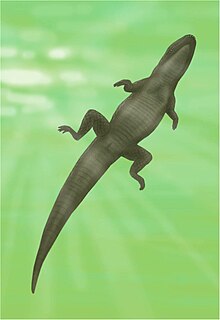Allognathosuchus
| Allognathosuchus | |
|---|---|

| |
| Fossil of Allognathosuchus | |
| Scientific classification | |
| Domain: | Eukaryota |
| Kingdom: | Animalia |
| Phylum: | Chordata |
| Class: | Reptilia |
| Clade: | Archosauromorpha |
| Clade: | Archosauriformes |
| Order: | Crocodilia |
| Family: | Alligatoridae |
| Subfamily: | Alligatorinae |
| Genus: | †Allognathosuchus |
| Species | |
| |

Allognathosuchus is an extinct genus of alligatorine crocodylian with a complicated taxonomic history. It was a medium sized predator up to 1.5 m in length.[1] This small alligatorine is known for its stout jaws and bulbous teeth, found near the rear of the tooth row in upper and lower jaws. These adaptations have historically been interpreted as having been for crushing mollusks. Isolated bulbous teeth are often assigned to this genus, although such teeth are known from other crocodyliform lineages. The type species, A. polyodon, is from the Eocene-age Bridger Formation of Wyoming; it is based on fossils that are difficult to distinguish from other Paleogene alligatorids. A. heterodon is from the Eocene-age Wasatch Formation of Wyoming, A. wartheni is from the Eocene-age Wildwood Formation (also known as the "Wildwood alligatorid," and possibly two species), and A. woutersi, which may belong to Diplocynodon instead, is from the Early Eocene of Belgium. A. polyodon, A. heterodon, and A. wartheni span the Clarkforkian, Wasatchian, and Bridgerian North American Land Mammal Ages.[2]
Several other genera and species have been assigned to Allognathosuchus over the years, giving it a potential Upper Cretaceous-Oligocene stratigraphic range, and a geographic range covering North America, Europe, and Africa. Christopher Brochu reviewed the genus in 2004 and, in light of the fragmentary remains of several of the species involved, recommended conservative usage of the genus. He excluded Albertochampsa langstoni, Arambourgia gaudryi, and Wannaganosuchus brachymanus from Allognathosuchus, and, finding the species Allognathosuchus haupti and A. mooki to not group with A. polyodon to the exclusion of other alligatorines, recommended using previously established generic names for those species instead: Hassiacosuchus haupti and Navajosuchus mooki.[2]
References
- ^ http://eocene.dmns.org/eocene-paleozoo/allognathosuchus/
- ^ a b Brochu, Christopher A. (2004). "Alligatorine phylogeny and the status of Allognathosuchus Mook, 1921". Journal of Vertebrate Paleontology. 24 (4): 857–873. doi:10.1671/0272-4634(2004)024[0857:APATSO]2.0.CO;2. JSTOR 4524781.



